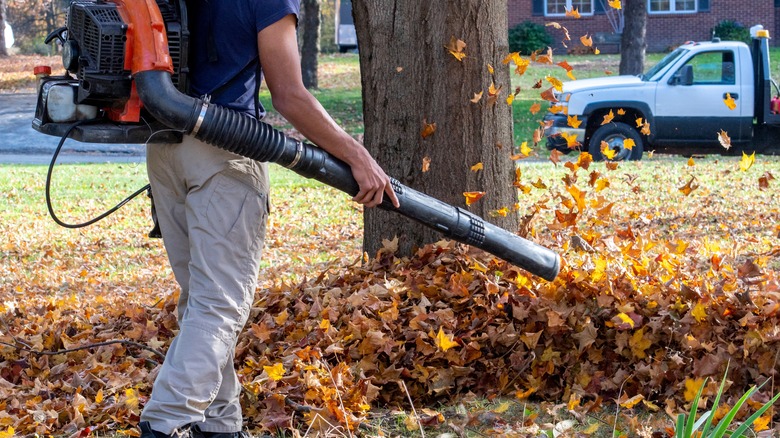What Is CFM On A Leaf Blower (& Why It Matters When Buying One)
We may receive a commission on purchases made from links.
Unless you enjoy raking and the unbearable back pain the task rewards you with, leaf blowers are an essential yard maintenance tool that helps keep your outdoor area clean. But even though using leaf blowers saves time and is easier on your back compared to raking, you still want a machine that can clear debris from your entire yard quickly and efficiently (right?). Alas, choosing this essential landscaping tool can be difficult if you have little experience with these tools. Partly, that's because these machines come with lengthy descriptions that often include landscaping industry terms homeowners simply do not know. Case in point — you're looking up the meaning of CFM, an initialism that appears on most leaf blower product descriptions.
You're right to look up CFM because, as it turns out, it's a crucial performance metric in the world of blowers. CFM stands for cubic feet per minute and tells us how much air, in cubic feet, leaves a leaf blower's nozzle every minute. The more cubic feet of air a leaf blower can move in a minute, the larger the area of debris you're able to cover. Now, armed with this knowledge, you may assume that choosing a high-performance leaf blower is as easy as picking a model with the highest CFM. Unfortunately, it's not that simple. Before you can select a leaf blower that works for your yard, you'll need to understand one more industry initialism — MPH. This one's simple and stands for the same thing MPH means on your car's speedometer — miles per hour. Below, we'll explain how to make use of both the CFM and MPH metrics when buying a leaf blower.
How to use CFM and MPH ratings when choosing a leaf blower
So, you already know that a higher CFM value means you can cover a greater area and dispose of the dead leaves quickly. But fallen leaves don't always behave in the same manner when you point a leaf blower at them. On rainy days, they tend to stick together and put up a good fight when you try to blow them away. Having a high CFM won't make these pesky wet leaves budge; you'll simply be attacking more of them at the same time. And that's where MPH comes in. MPH measures the speed at which air leaves the blower in miles per hour. The higher the MPH rating, the more powerful the air stream, and the more likely you are to dislodge debris that's refusing to go away.
When shopping for a leaf blower, you'll typically see both the CFM and MPH values somewhere in the product description. For example, this cordless leaf blower from DeWalt has ratings of 450 CFM and 125 MPH. This means that it's able to move 450 cubic feet of air per minute, at a speed of 125 miles per hour. This ratio, with a higher CFM and lower MPH, means that the blower is a great choice for working on a large yard on dry days when the leaves don't stick together too much. On the other hand, this BLACK + DECKER electric leaf blower has a whooping 250 MPH speed (that's the airspeed of a Category 5 hurricane), and a 400 CFM rating. With this blower, you get lots of power, but an average ability to cover large portions of your yard quickly. For balanced performance, opt for blowers with ratings of over 150 MPH and 450 CFM.

